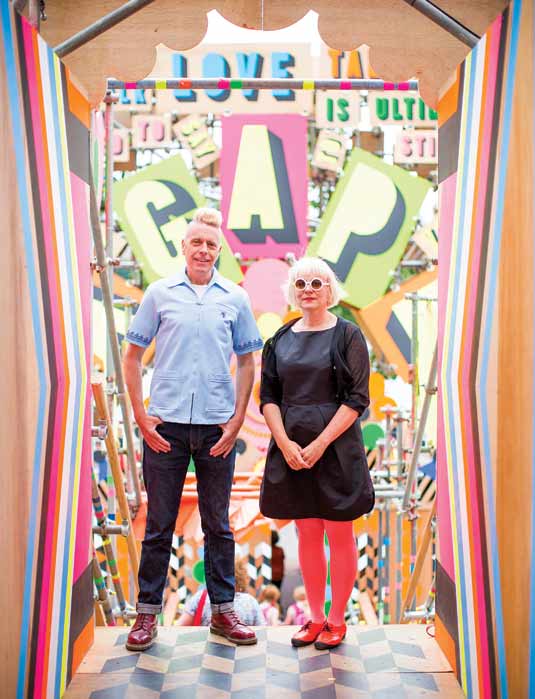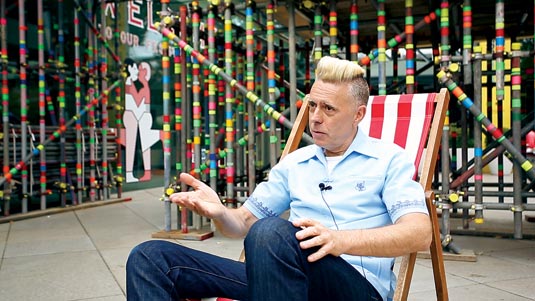Behind the scenes at London's Festival of Love temple installation
Supergroup London's co-founders talk surgical lamps, scaffolding and a summer of love at the Southbank Centre.
When the Southbank Centre sought a creative team to design an ambitious temple installation for its Festival of Love, Supergroup London got the call.
Measuring over eight metres high and 12 metres wide, the 'Temple of Agape' stood on the South Bank of the Thames like a welcome beacon, inviting all who pass to enter the scaffold structure and decode its compassionate message, set in an explosion of colourful typography.
Artists Morag Myerscough and Luke Morgan were commissioned to create the installation as part of a summer Festival of Love. Computer Arts caught up with them at Southbank Centre to find out why they so love working together...

When did you meet and what was the first project you both worked on?
Morag Myerscough: It was 2002 when we met. I'd been running my own studio for 10 years and I'd grown bored. That's when the two of us started doing projects together.
The first big project we did was the Her House gallery. It was actually in my house and was a collection of things that we'd both done even before we'd met. I remember I'd made a lampshade out of surgical tubing and Luke had made birdhouses. We just did what we wanted to do – and everybody loved it.
Luke Morgan: 'Curation' sounds like a posh word to describe it but we chose things to build this collection that we thought would work together and that had some sort of direction. This also inspired us to create new things at the time. We did it as an experiment for ourselves, but it took on a life of its own and it was a really interesting experience.
How do you benefit from working collaboratively?
MM: When we work on complex projects I think it's definitely better that we work together, as there's so much layering in big projects, I don't think you could do it on your own, or at least I don't think that would be the best way to go about it, because there's so many different elements that you have to think of.
LM: I think it's a performance for the both of us, but in slightly differing ways. Morag comes from a performing family and I've always had this urge to – in the most basic way – get attention. And maybe where I might have sought attention through the music I was playing [Morgan is the frontman of his own band, The Highliners], Morag has always been getting attention through activating spaces and getting people to enjoy and experience them.
Perhaps it's in the same way that I would sometimes go busking and people would get something out of it that wasn't necessarily arranged, but it would become an experience that we could all share. I think Morag does that through the way she changes spaces.

What was the brief for Temple of Agape?
MM: Southbank Centre's original brief was quite simple: they had a Martin Luther King quote about love that they wanted us to use, while the theme of the temple had to be 'agape' – the love of humanity.
It was a very fast turnaround. I drew the temple, then we made a model of it, which we showed to Southbank Centre. They really liked it, so we developed it from there. Our engineer worked directly with the scaffolding team, while we painted the wooden boards in my studio over a period of three weeks. I think we achieved the brief: people seem to feel the love and feel a connection to it.
The arts charity Beam asked you to activate a space at the Orangery. Tell us about Swing It...
LM: The Orangery by Wakefield station is a lovely old listed building that has a secret garden behind it. Part of the brief was to invite people into it for the summer. It's all on one level and has a high wall around it.
We had to express ourselves and attract attention over this wall, so we erected 10-metre high scaffolding tubes with signs on them and a collection of wind-powered mobiles – signs that move with the direction of the wind.
We also created a playground with swings, so that the kinetic movement of the people on the swings moved the signs. So we were trying to get attention in as many ways as we could from people, to say 'come here and play
How was Supergroup formed – what was the idea behind this creative 'A-Team'?
MM: Supergroup was founded by Luke, myself, and one of our friends called Gerrard, who sadly passed away. We were involved in some projects that required lots of different people to come together and it was getting hard to credit all of them. So we thought the best thing to do was to come up with a collective name.
Also, when you work on different projects, different sets of people are involved. So it's always been about creating a cohesive team – who are not necessarily all creatives – and combining different people for different projects. For example, neither I nor Luke are digital artists, but one of us might have an idea that needs to be digitally realised, so we'll bring someone in who has that expertise.
LM: When we start a project we look at how we're going to tackle it, and it often begins with a pitch, so we'll put a scheme together between us and work out who's doing what and what times we have available, and who has certain specific elements they want to put into it. For example, with the Temple of Agape, you can clearly see Morag's visual influence.
This article first appeared in Computer Arts issue 231, Self-Promo to Suit You – 100 pages on how to win more design work by playing to the strengths of your personality, and much more.
Get 10 free issues of Computer Arts
Take out a two-year subscription to Computer Arts before the end of October, and you'll get an incredible 10 free issues of the world's leading design magazine.
Simply head over to the CA subs page, select Europe or Rest of World from the Delivery Region menu, and choose 'Credit/Debit Card or PayPal 2 Year' from the three options.

Thank you for reading 5 articles this month* Join now for unlimited access
Enjoy your first month for just £1 / $1 / €1
*Read 5 free articles per month without a subscription

Join now for unlimited access
Try first month for just £1 / $1 / €1
Get the Creative Bloq Newsletter
Daily design news, reviews, how-tos and more, as picked by the editors.

Julia is editor-in-chief, retail at Future Ltd, where she works in e-commerce across a number of consumer lifestyle brands. A former editor of design website Creative Bloq, she’s also worked on a variety of print titles, and was part of the team that launched consumer tech website TechRadar. She's been writing about art, design and technology for over 15 years.